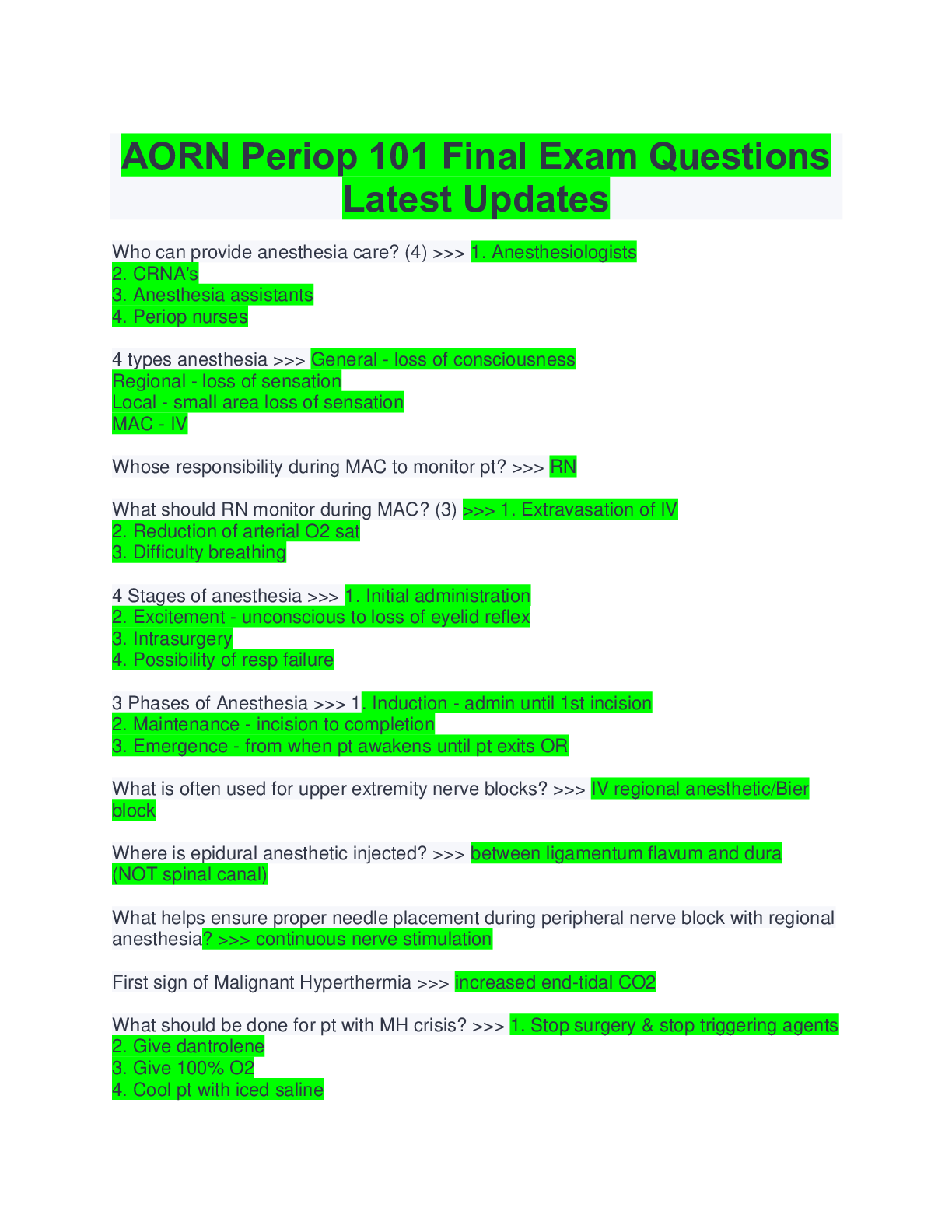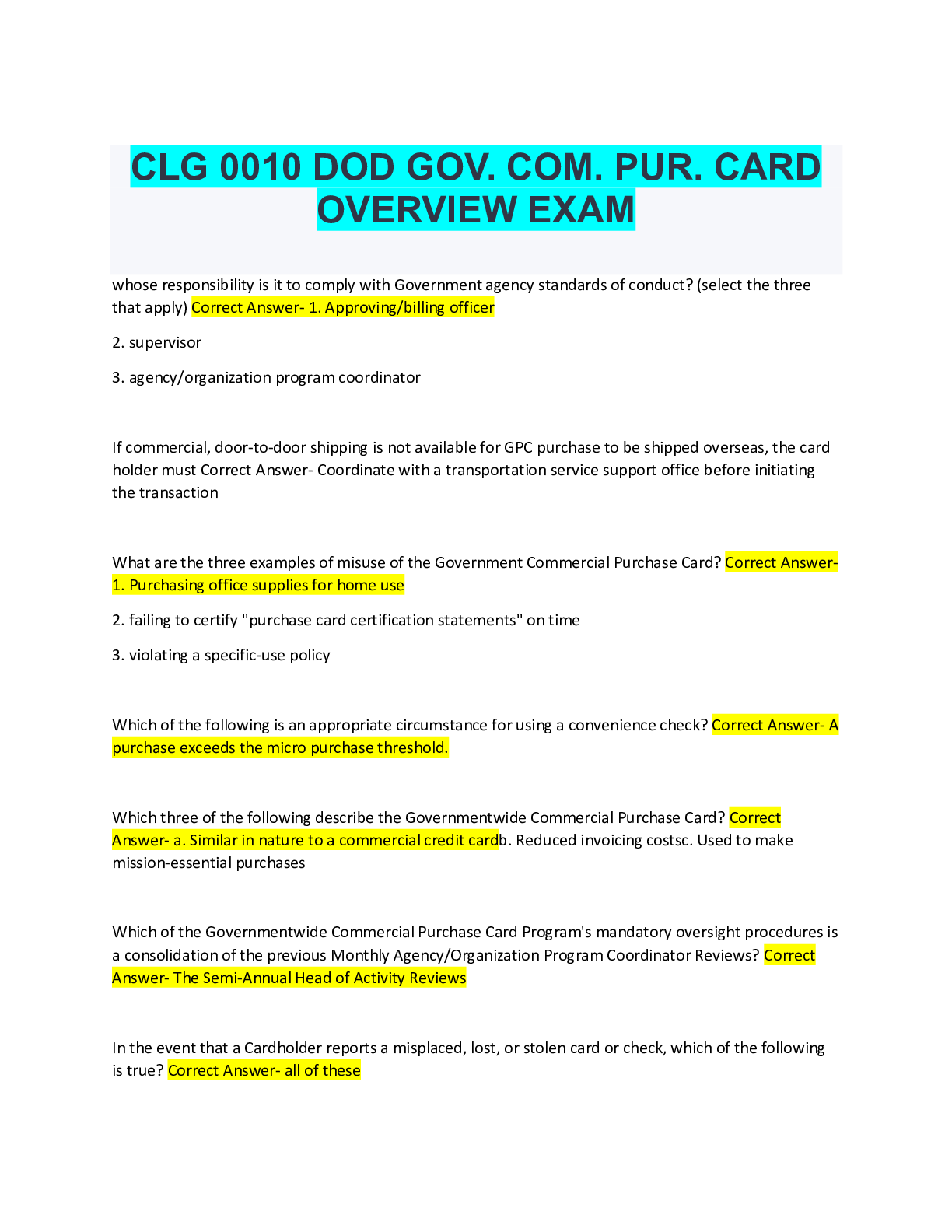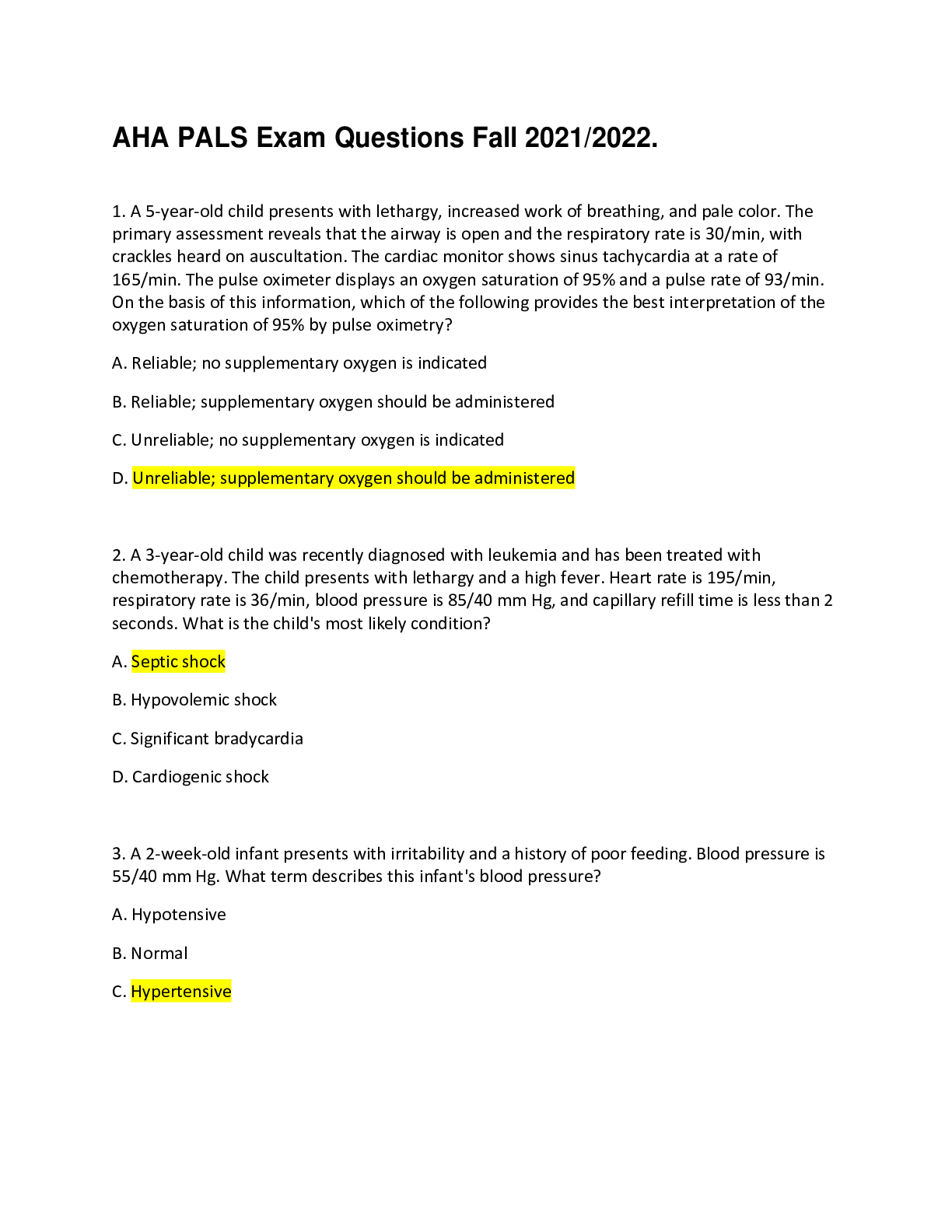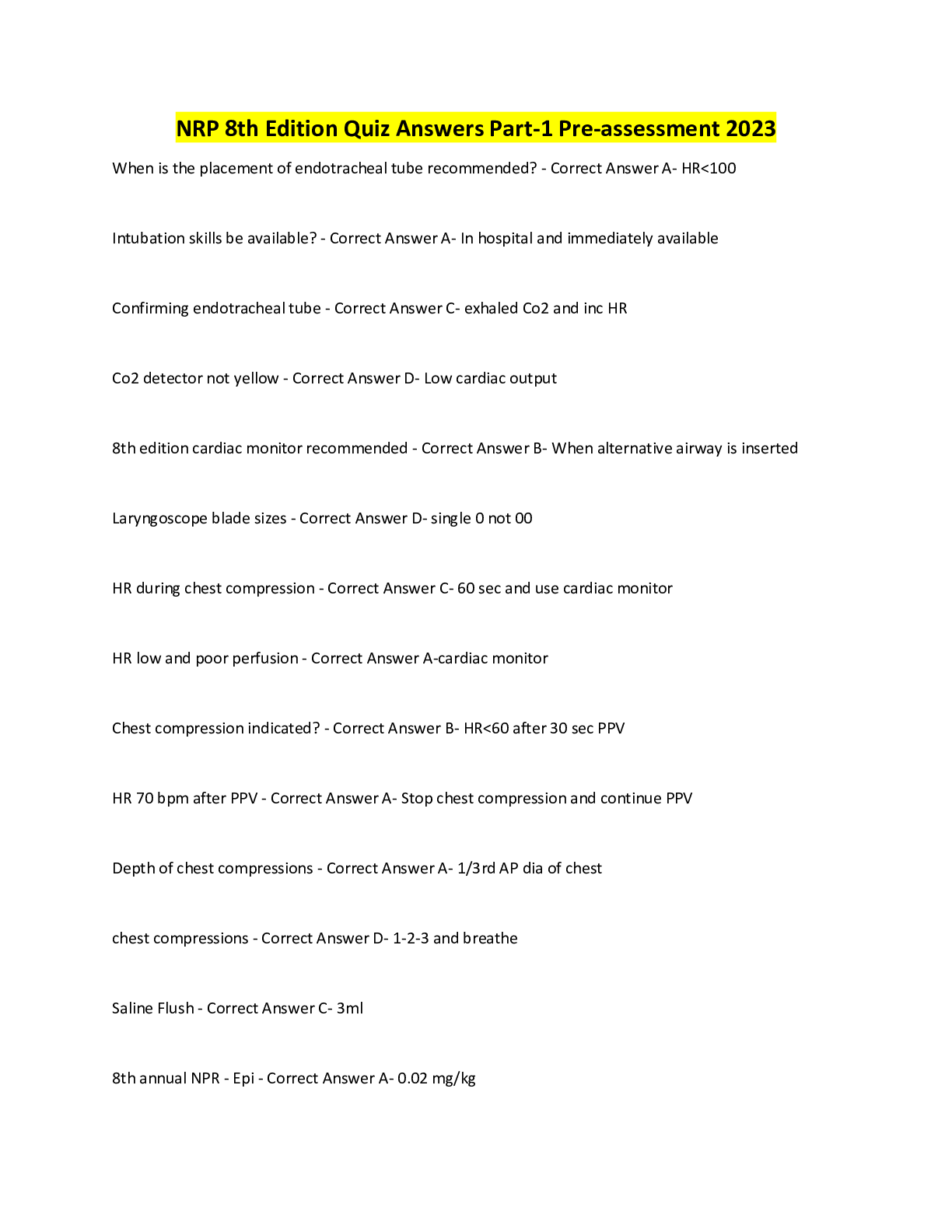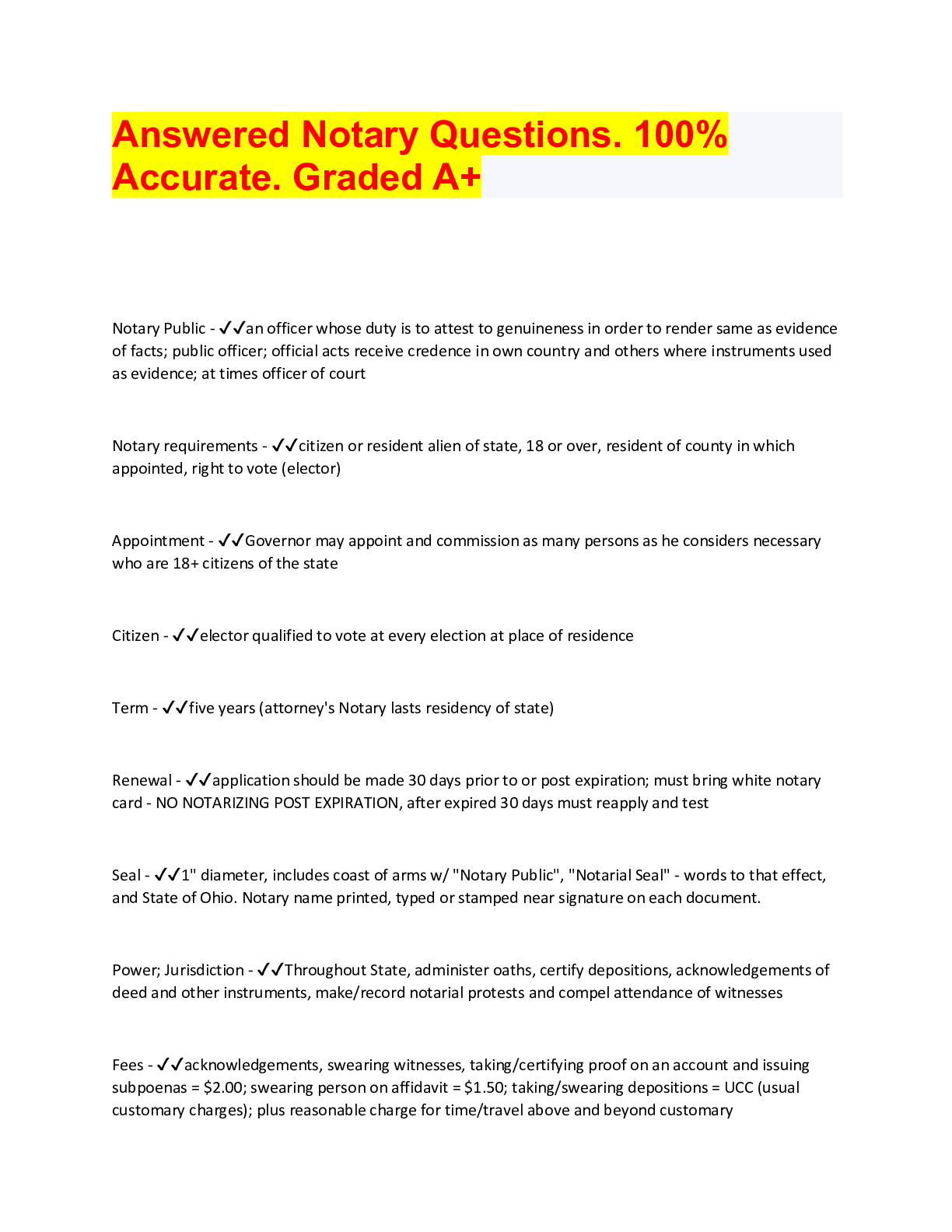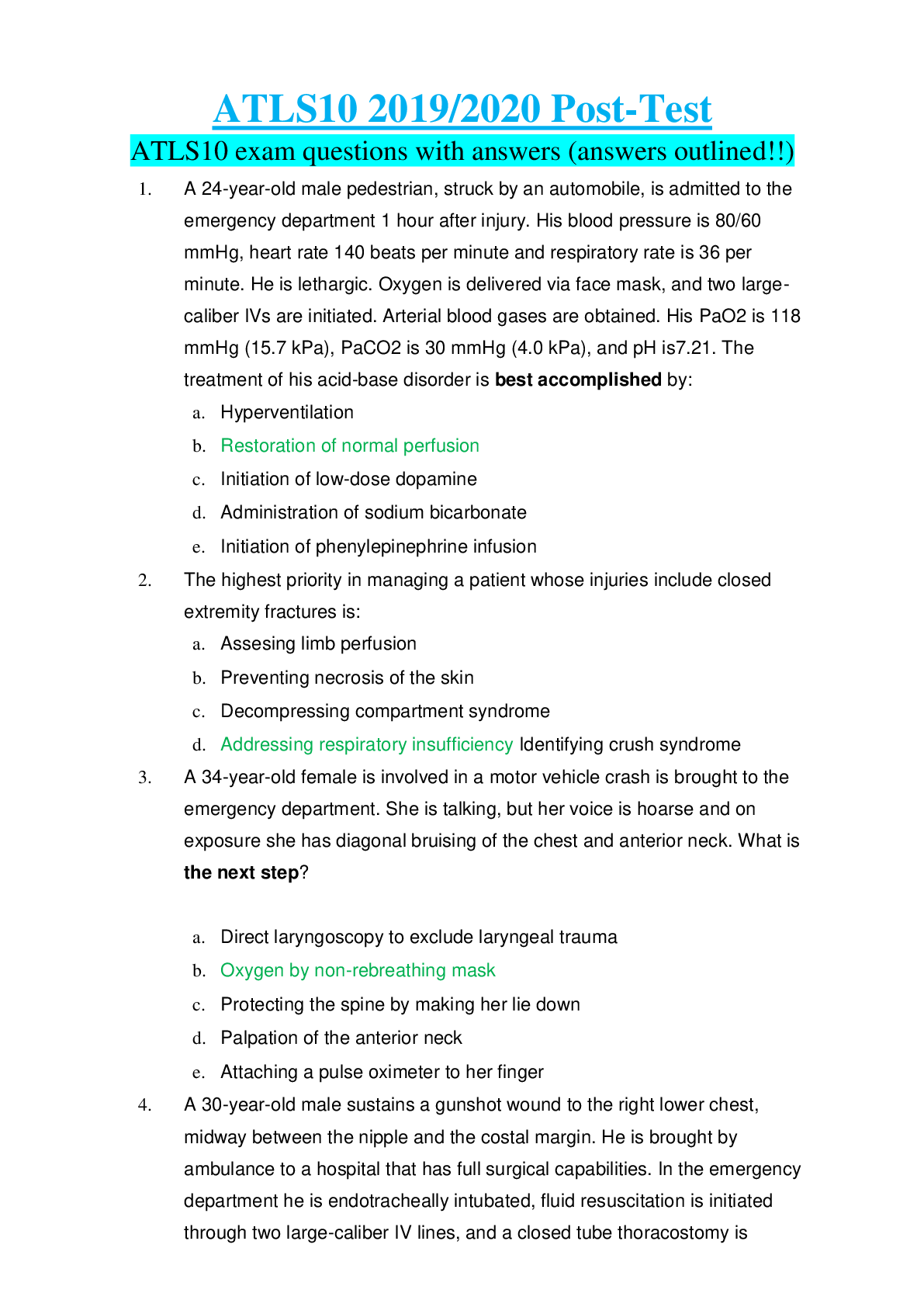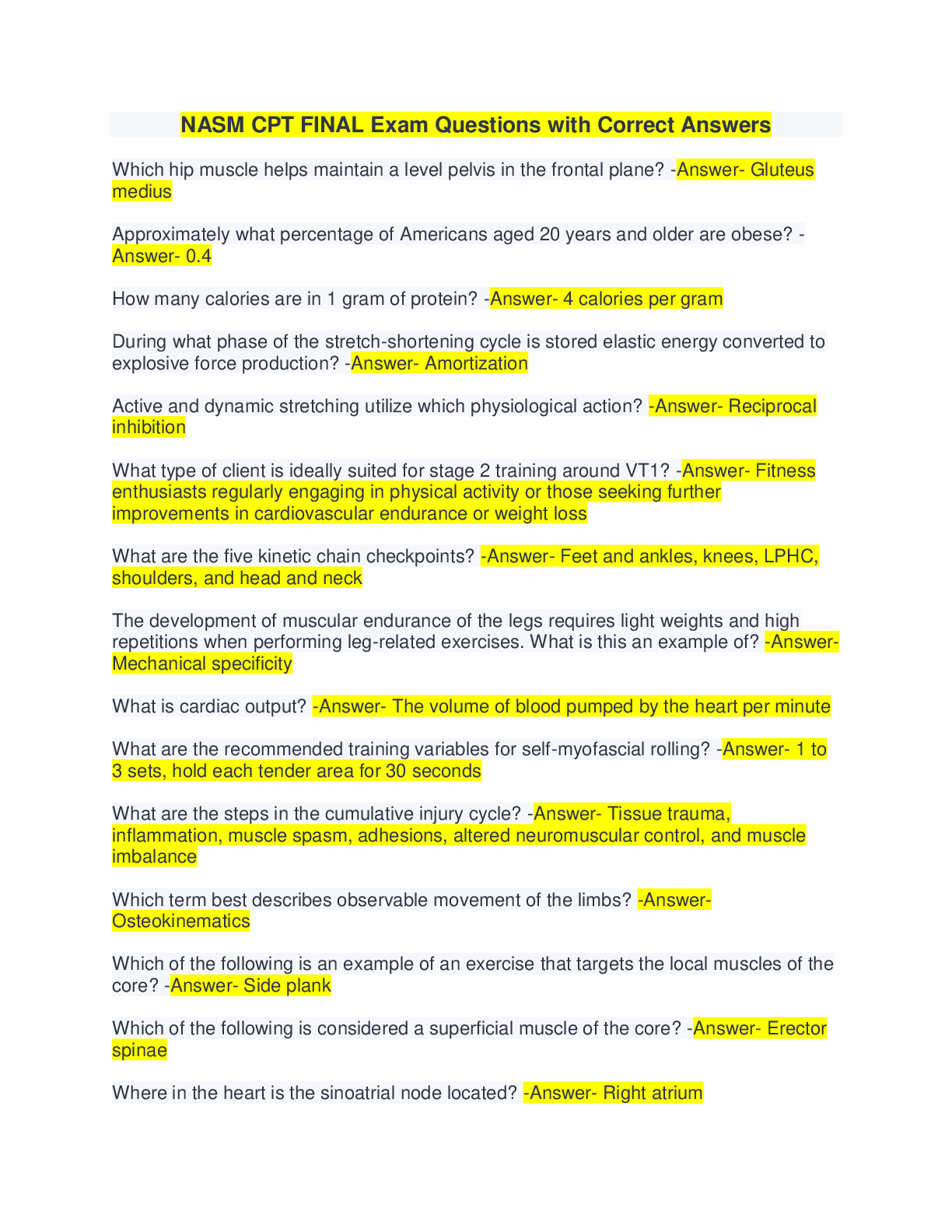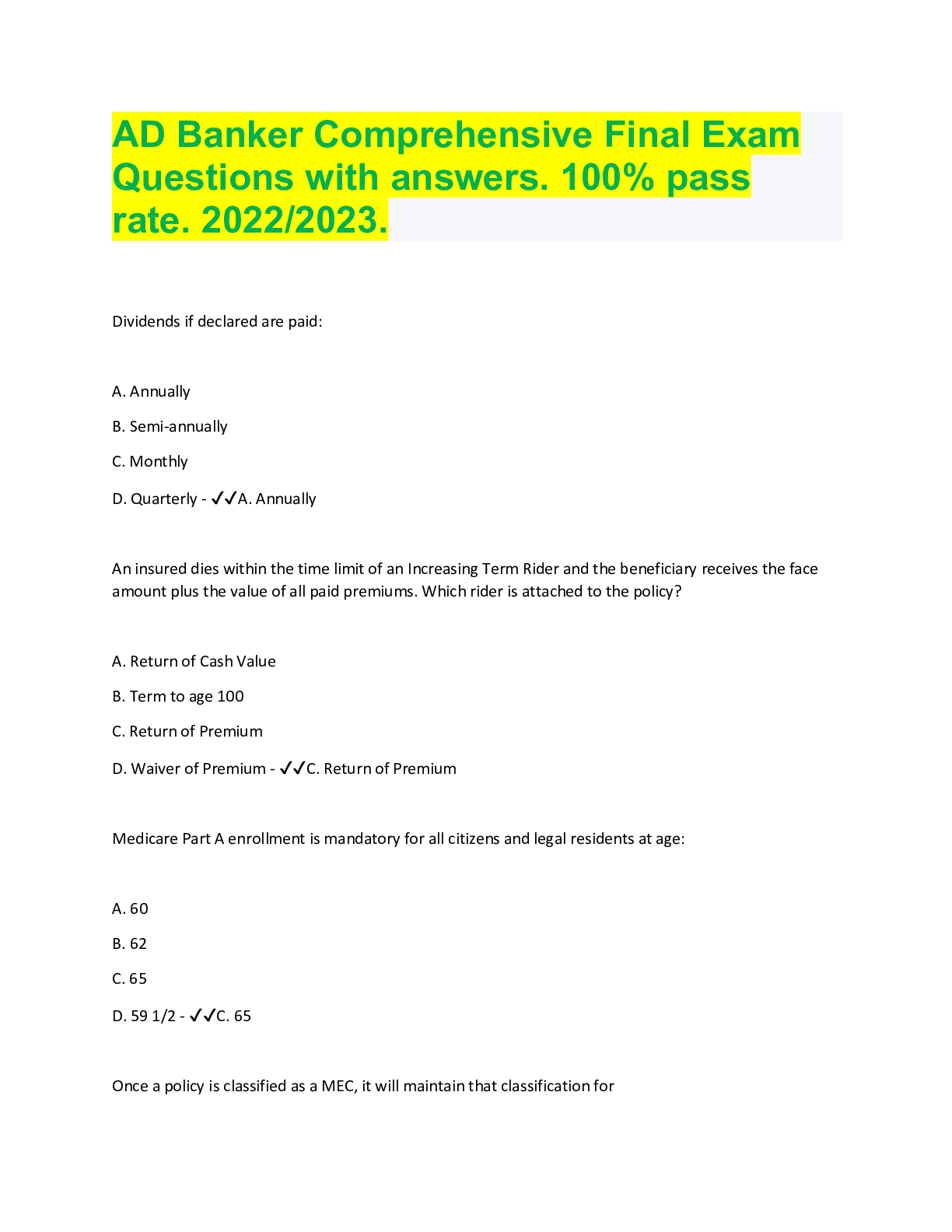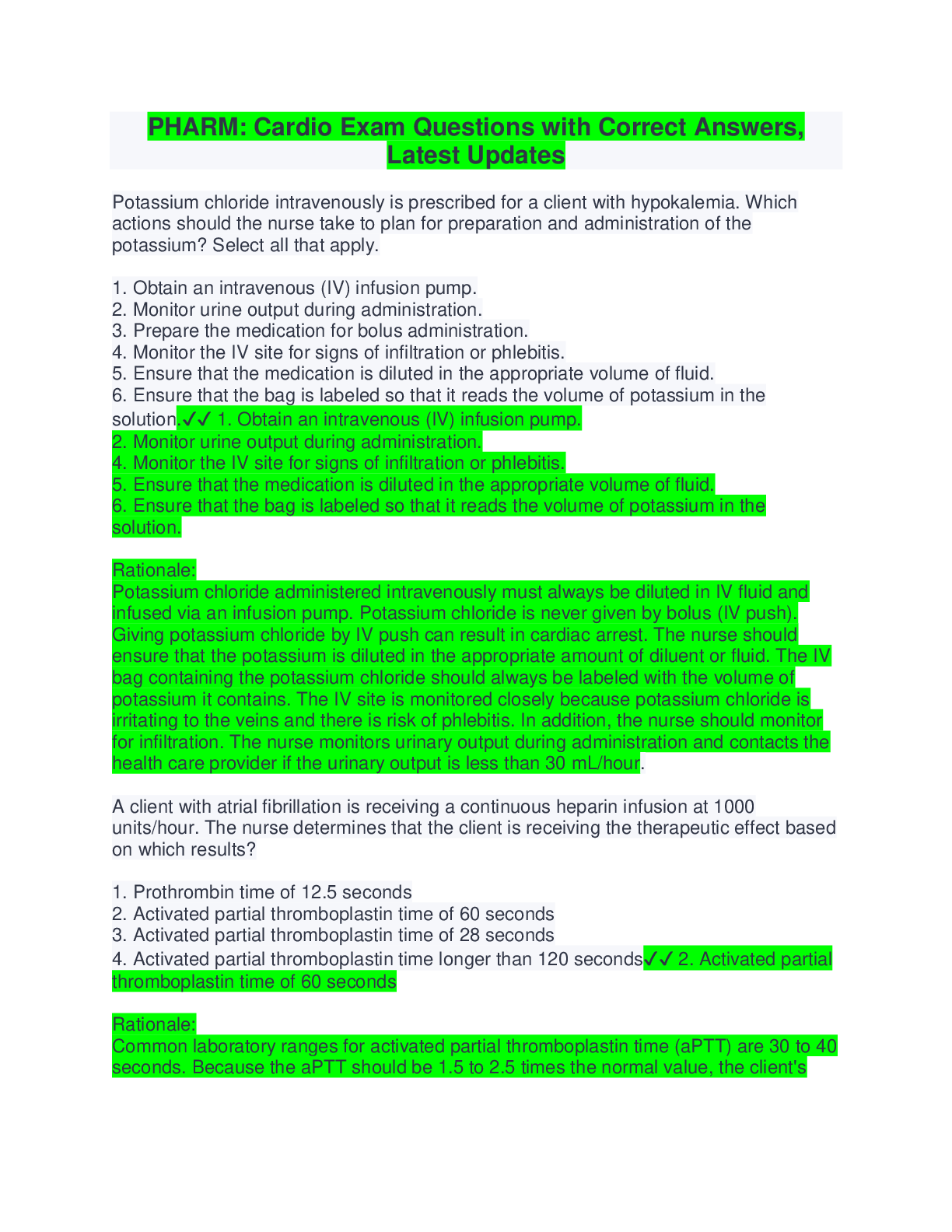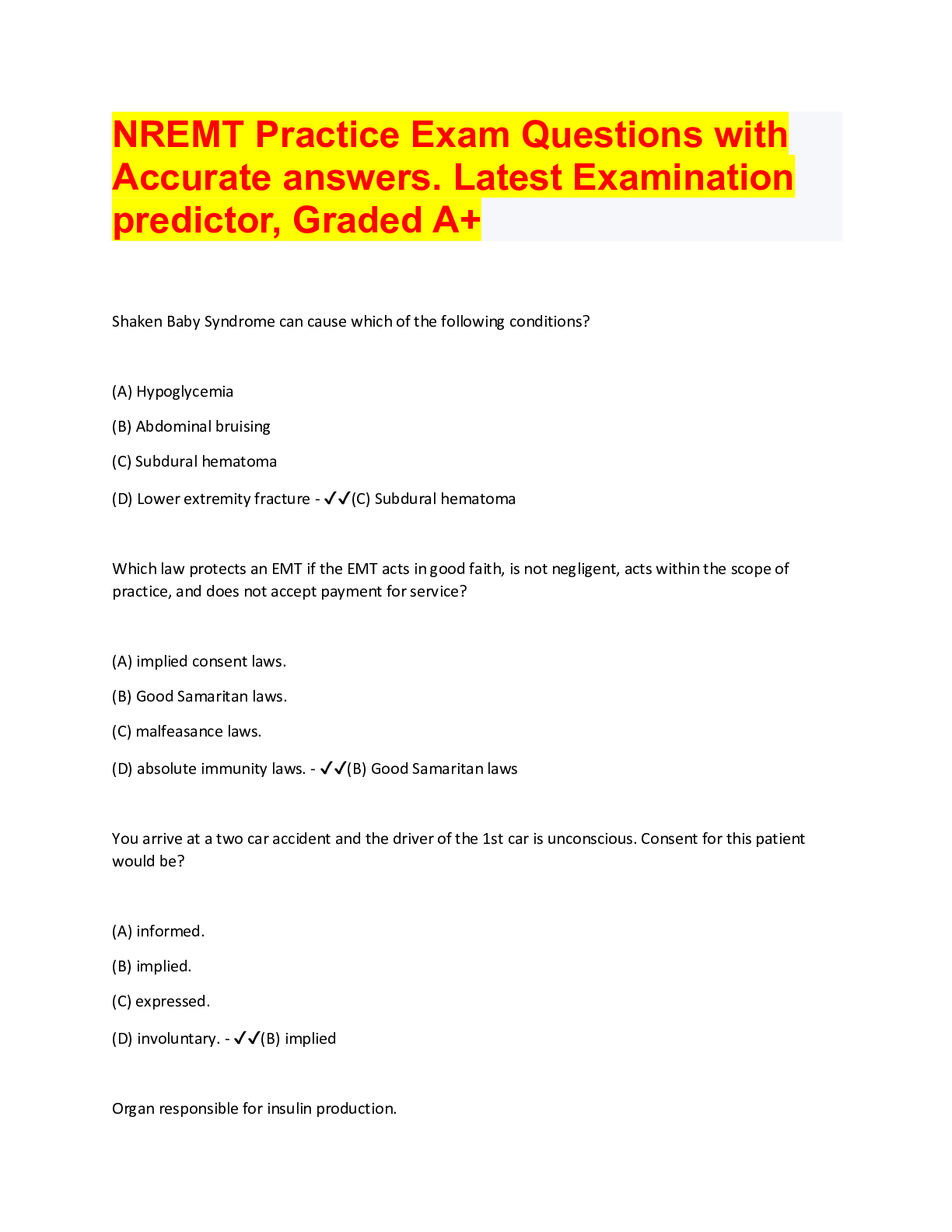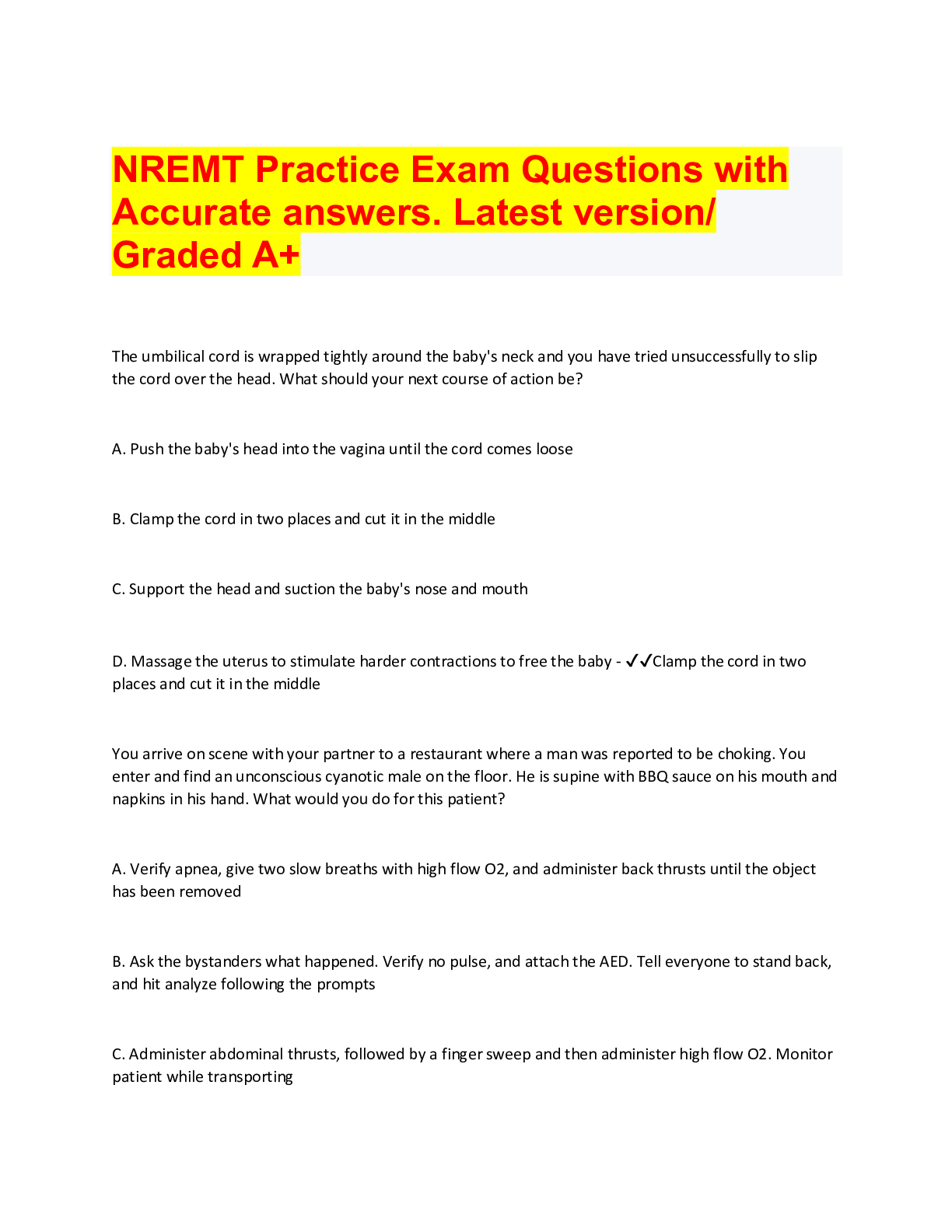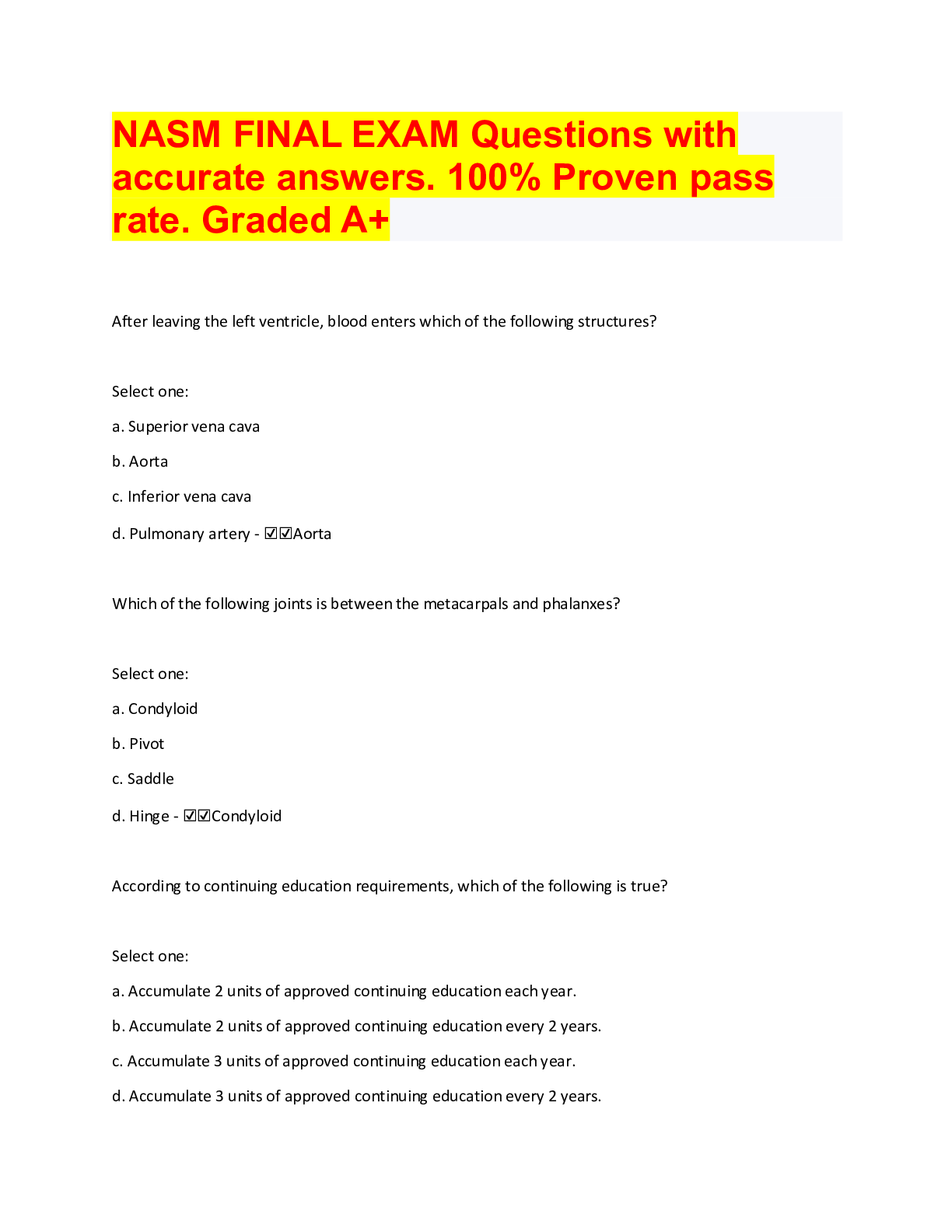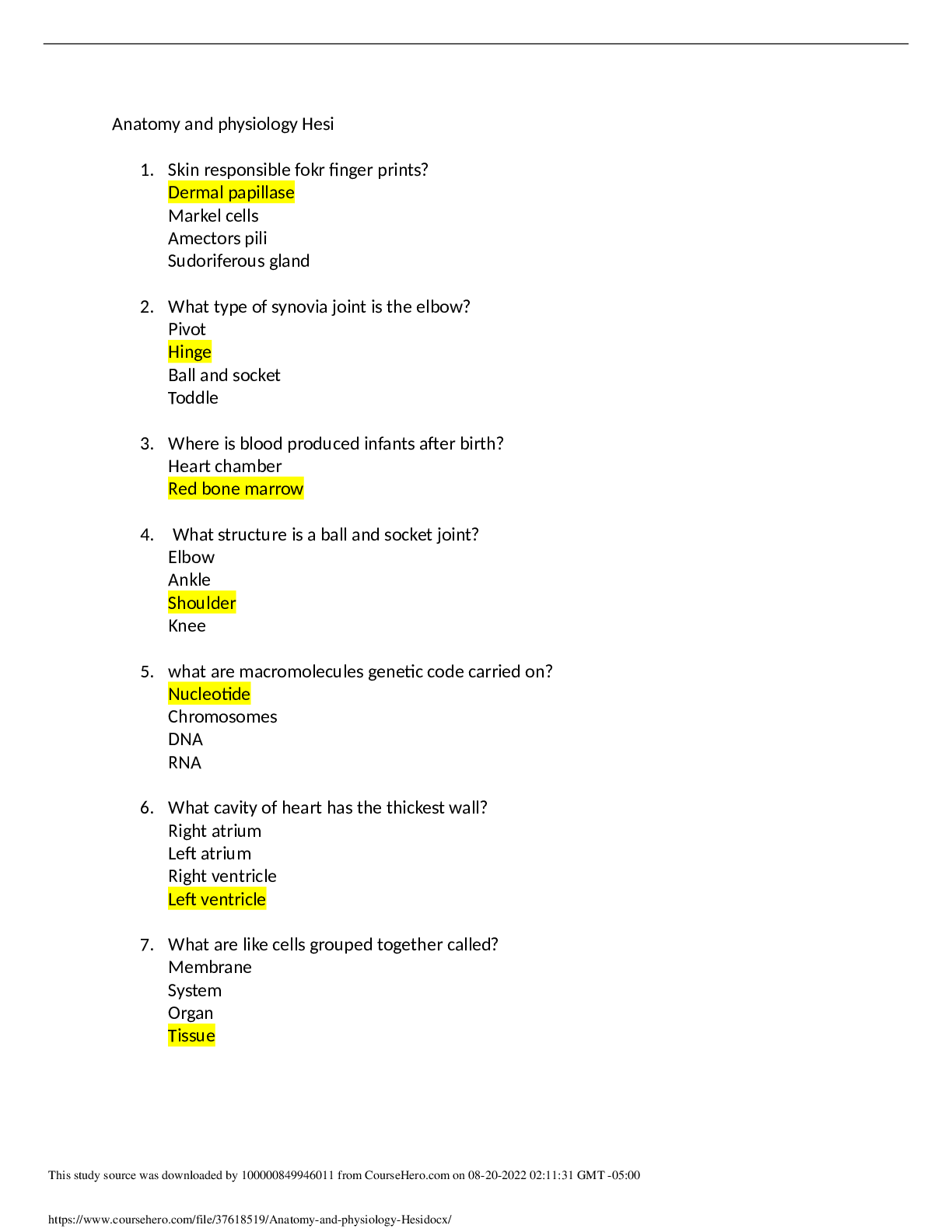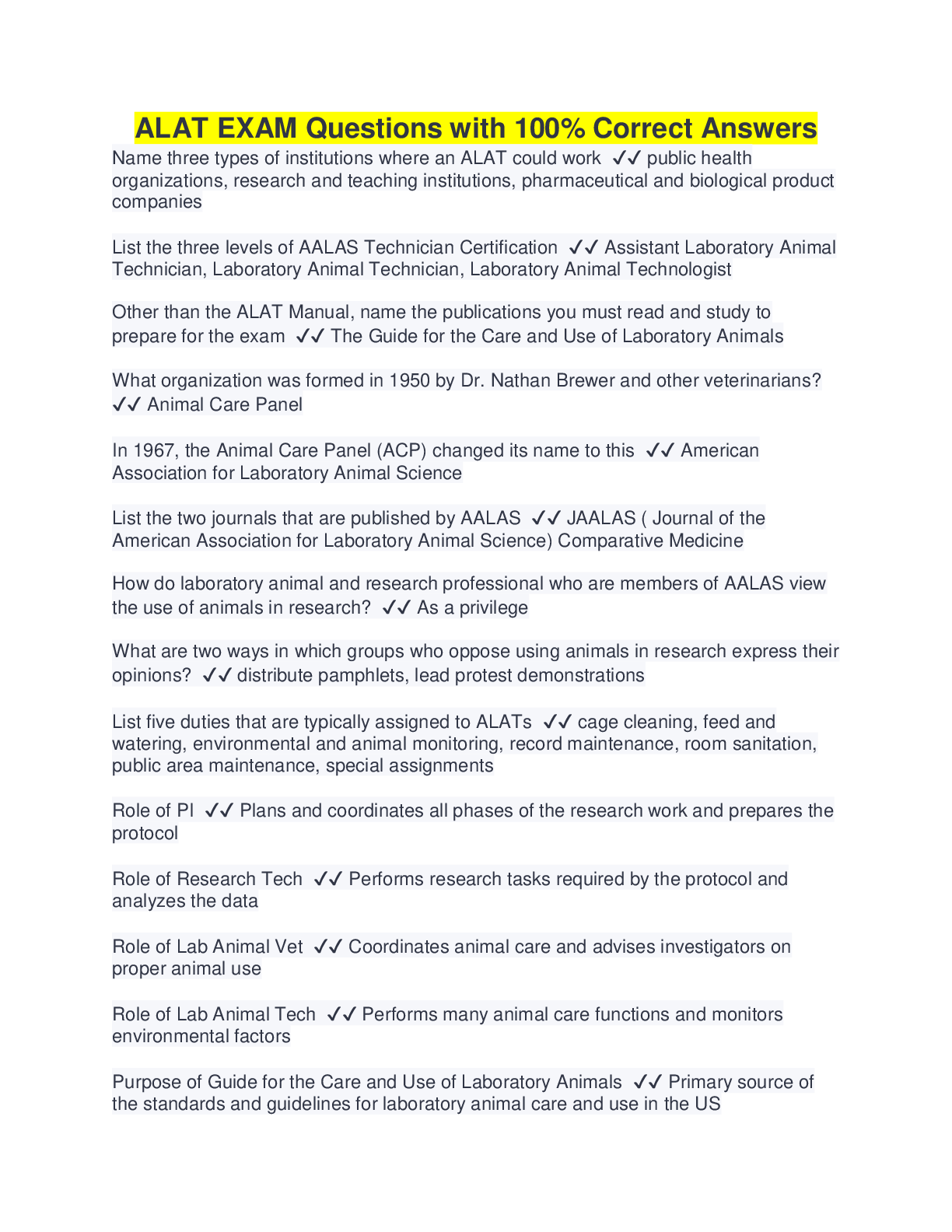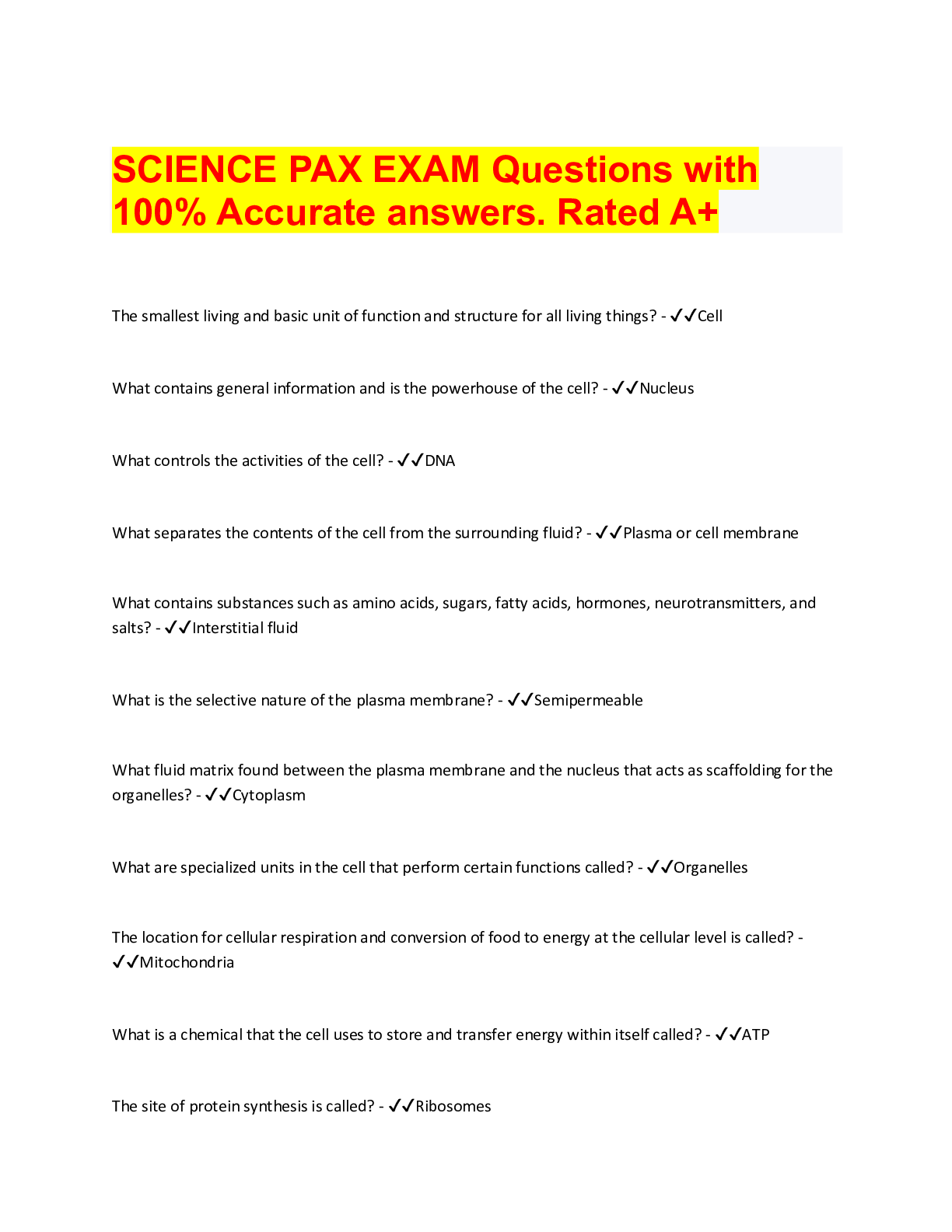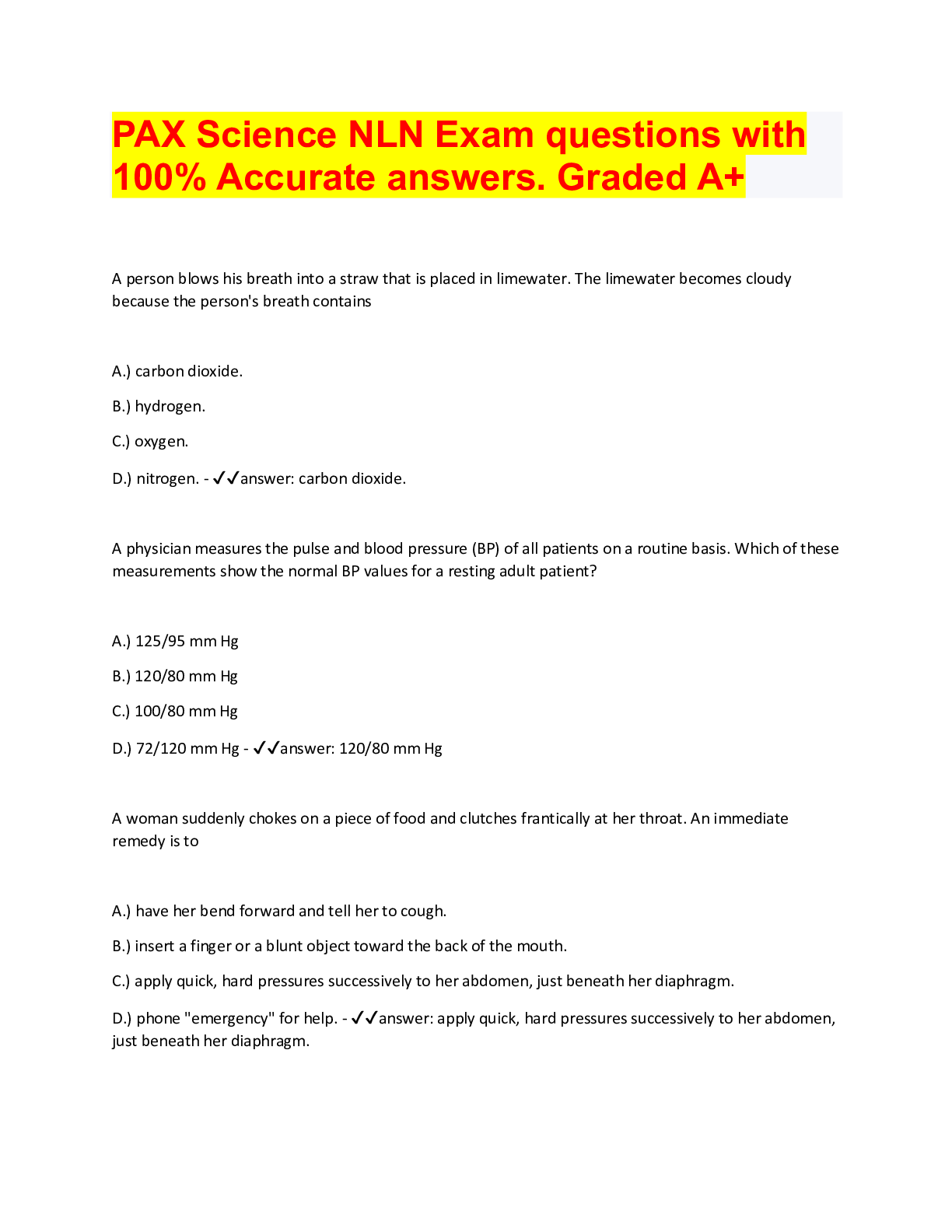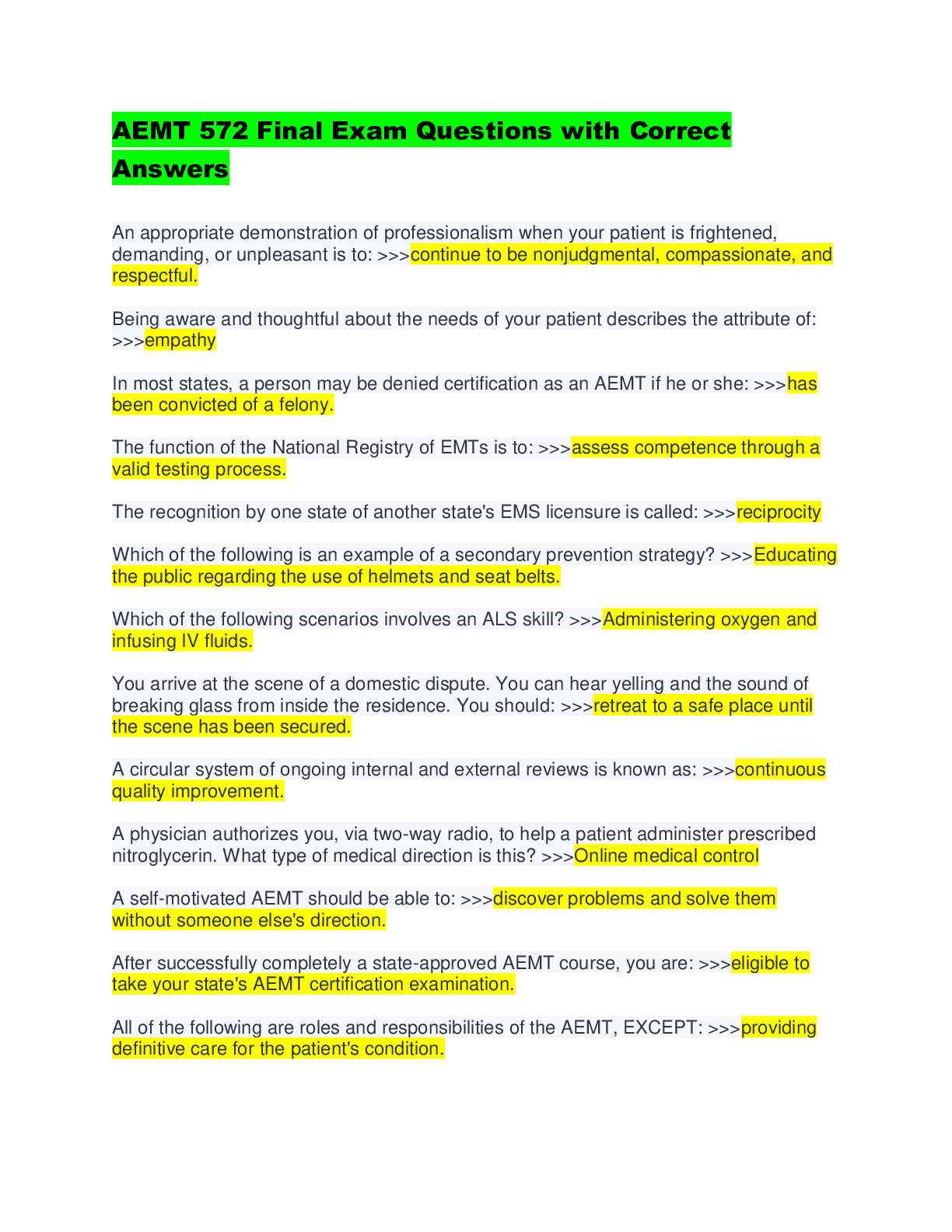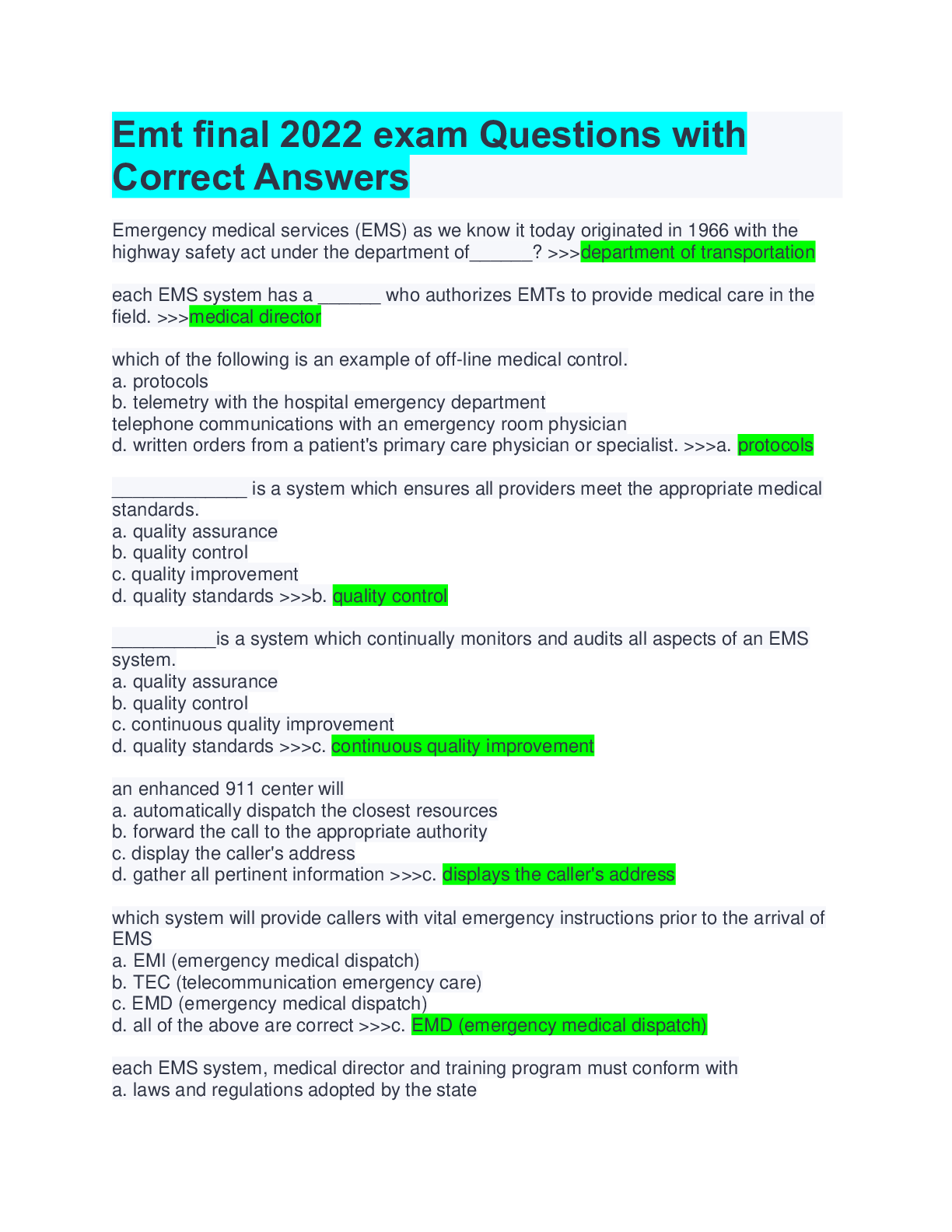*NURSING > QUESTIONS & ANSWERS > TMC practice exam Questions with answers, Graded A+. 100% approved pass rate (All)
TMC practice exam Questions with answers, Graded A+. 100% approved pass rate
Document Content and Description Below
1. Within one second after initiating a forced vital capacity (FVC) maneuver, a patient with normal lungs should be able to exhale what percent of the FVC? A. 35-50% of the FVC B. 50-70% of the FVC ... C. 70-83% of the FVC D. 84-93% of the FVC -☑☑c. 70-83% of FVC 2. Simple spirometry CANNOT be used to measure the A. vital capacity B. residual volume C. tidal volume D. inspiratory reserve volume -☑☑b. residual volume 3. Which of the following approaches can be used to obtain a medication history from a patient with a depressed level of consciousness or who is severely agitated? A. obtain and review the patient's past medical history B. ask the patient's nurse about the patient's prescriptions C. request that the lab run a comprehensive blood drug screen D. obtain the patient's current prescription vials from the family -☑☑d. obtain the patient's current prescription vials from the family 4. Which of the following thoracic ultrasound findings is consistent with the presence of a pneumothorax? A. presence of gliding sign B. absence of A-lines C. presence of barcode sign D. presence of seashore sign -☑☑c. presence of barcode lines 5. Which of the following would tend to increase insensible water loss? A. hypothermia B. bypassed upper airway C. hypoventilation D. diuretic administration -☑☑b. bypassed upper airway 6. Which of the following would tend to decrease a patient's energy expenditure? A. hypothermia B. inflammation C. major trauma D. agitation/pain -☑☑a. hypothermia 7. A patient has acute respiratory acidosis. You would expect the base excess (BE) to range between: A. + 6 mEq/L B. - 6 mEq/L C. +/- 2 mEq/L D. +/- 8 mEq/L -☑☑c. +/- 2 mEq/L 8. Which of the following arterial blood gas results would most likely be reported for a patient who is having a mild asthma attack? A. pH = 7.31 PCO2 = 50 torr PO2 = 60 torr B. pH = 7.40 PCO2 = 50 torr PO2 = 50 torr C. pH = 7.47 PCO2 = 32 torr PO2 = 60 torr D. pH = 7.47 PCO2 = 40 torr PO2 = 50 torr -☑☑c. pH= 7.47 PCO2= 32 torr PO2= 60 torr 9. The Apgar score for a normal newborn infant ranges between A. 1-4 B. 4-7 C. 7-10 D. 10-13 -☑☑c. 7-10 10. On inspection of a patient's ECG strip, you note no identifiable P waves; rapid irregular undulations of the isoelectric line; and an irregular ventricular rhythm. In addition, the precordial cardiac rate is greater than the peripheral pulse rate. The most likely problem is: A. 2nd degree (Wenckebach) heart block B. ventricular fibrillation C. atrial fibrillation D. ventricular tachycardia -☑☑c. atrial fibrillation 11. In inspecting an elderly female patient, you note that her spine has an abnormal anterposterior (AP) curvature. Which of the following terms would you use in charting this observation? A. kyphosis B. scoliosis C. kyphoscoliosis D. pectus excavatum -☑☑a. kyphosis 12. During auscultation of a patient's chest, you hear intermittent "bubbling" sounds at the lung bases. Which of the following chart entries best describe this finding? A. "bronchial sounds heard at lung bases" B. "wheezes heard at lung bases" C. "rhonchi heard at lung bases" D. "crackles (rales) heard at lung bases" -☑☑d. "crackles (rales) heard at lung bases" 13. While assessing a patient's radial pulse, you note that the pulse feels full and bounding. Which of the following conditions would be the most probable cause of this finding? A. hypovolemia B. hypertension C. cardiovascular shock D. low cardiac output -☑☑b. hypertension 14. A patient is cachexic, exhibits generalized edema and dry skin, and appears listless. The most likely problem is: A. heart failure B. Addison's disease C. renal failure D. malnutrition -☑☑d. malnutrition 15. Prior to giving an aerosol treatment, you find a note in the chart that states your patient had pink frothy secretions on admission to the ED. This is most indicative of: A. cor pulmonale B. left ventricular failure C. an electrolyte imbalance D. ARDS -☑☑b. left ventricular failure 16. A doctor orders a changeover to CPAP for a patient receiving bi-level positive airway pressure (BiPAP) via a device with separate IPAP and EPAP controls. To effect this change you would: A. set IPAP less than EPAP B. set IPAP greater than EPAP C. set EPAP = 0 cm H2O D. set IPAP equal to EPAP -☑☑a. set IPAP less than EPAP 17. How would you characterize the degree of dyspnea of a patient who walks slower than people of the same age because of breathlessness? A. slight B. moderate C. severe D. very severe -☑☑b. moderate 18. Upon exam of an acutely dyspneic and hypotensive patient, you note the following - all on the left side of the chest: reduced chest expansion, hyperresonance to percussion, absent of breath sounds and tactile fremitus, and a tracheal shift to the right. These findings suggest: A. left-sided pneumothorax B. left-sided consolidation C. left lobar obstruction/atelectasis D. left-sided pleural effusion -☑☑a. left-sided pneumothorax 19. A patient's response to an interview question is initially vague or unclear. Which of the following responses on your part would be most appropriate? A. "Please go on" B. "You seem to be anxious" C. "I see why you are so upset" D. "Please explain that to me again" -☑☑d. "please explain that to me again" 20. A patient is asked to inhale as deeply as possible and blow out all his air as hard as they can until empty. What test is being performed? A. FVC B. IC C. TLC D. MVV -☑☑a. fvc 21. When a patient is receiving positive-pressure ventilation, you should strive to keep the alveolar (plateau) airway pressure below: A. 20 cm H2O B. 30 cm H2O C. 40 cm H2O D. 50 cm H2O -☑☑b. 30 cm H2O 22. On inspection of an ECG rhythm strip from an adult patient, you note the following: rate of 150; regular rhythm; normal P waves, P-R intervals, and QRS complexes. The most likely problem is: A. atrial flutter B. sinus tachycardia C. ventricular tachycardia D. atrial fibrillation -☑☑b. sinus tachycardia 23. On inspection of a 12-lead ECG, you note the absence of P waves and a variable R-R interval (> 0.12 sec). Which of the following is the most likely problem? A. atrial hypertrophy B. first-degree heart block C. atrial fibrillation D. sinus arrhythmia -☑☑c. atrial fibrillation 24. What percent decrease in FEV1 needs to occur to conclude that a methacholine challenge is positive for airway hyperreactivity? A. 10% B. 15% C. 20% D. 25% -☑☑c. 20% 25. A patient is receiving ventilatory support after thoracic surgery. You measure the patient's maximum inspiratory pressure (MIP/NIF) as -33 cm H2O. Based on this value, the patient has: A. a need for continued ventilatory support B. a large leak in their endotracheal tube cuff C. a normal maximum inspiratory pressure D. adequate muscle strength to consider weaning -☑☑d. adequate muscle strength to consider weaning 26. During a single-breath capnogram, the sharp downstroke and return to baseline that normally occurs after the end-tidal point indicates: A. exhalation of mainly deadspace gas B. inspiration of fresh respiratory gas C. exhalation of mixed alveolar/deadspace gas D. exhalation of mainly alveolar gas -☑☑b. inspiration of fresh respiratory gas 27. A patient is considered as having sufficient respiratory muscle strength to maintain adequate ventilation and prevent secretion retention when the maximum inspiratory pressure (MIP; NIF) is more negative than: A. -5 cm H2O B. -10 cm H2O C. -15 cm H2O D. -20 cm H2O -☑☑d. -20 cm H2O 28. Over a 3 hour period, the plateau pressure of a patient receiving volume controlled ventilation has remained stable, but her peak pressure has been steadily increasing. Which of the following is the best explanation for this observation? A. the patient's airway resistance has increased B. the patient is developing atelectasis C. the patient's compliance has decreased D. the patient is developing pulmonary edema -☑☑a. the patient's airway resistance has increased 29. On inspection of an adult patient's 12-lead ECG, you note a regular R-R interval of 0.40 sec, with no other apparent abnormalities. Which of the following is the most likely problem? A. ventricular tachycardia B. sinus bradycardia C. atrial fibrillation D. sinus tachycardia -☑☑d. sinus tachycardia 30. Under ideal conditions, pulse oximeter readings patients usually fall with what percent of those obtained via invasive hemoximetry? A. ±1-2% B. ±2-3% C. ±3-5% D. ±5-7% -☑☑+/- 3-5% 31. Prior to intubation in an emergency, injection of air into the pilot line fails to inflate the cuff. You should: A. check the cuff for leaks B. check the valve on the pilot line C. replace the endotracheal tube D. inspect the pilot line for patency -☑☑c. replace the endotracheal tube 32. A 15-year-old with cystic fibrosis is receiving pressure control SIM [Show More]
Last updated: 1 year ago
Preview 1 out of 20 pages
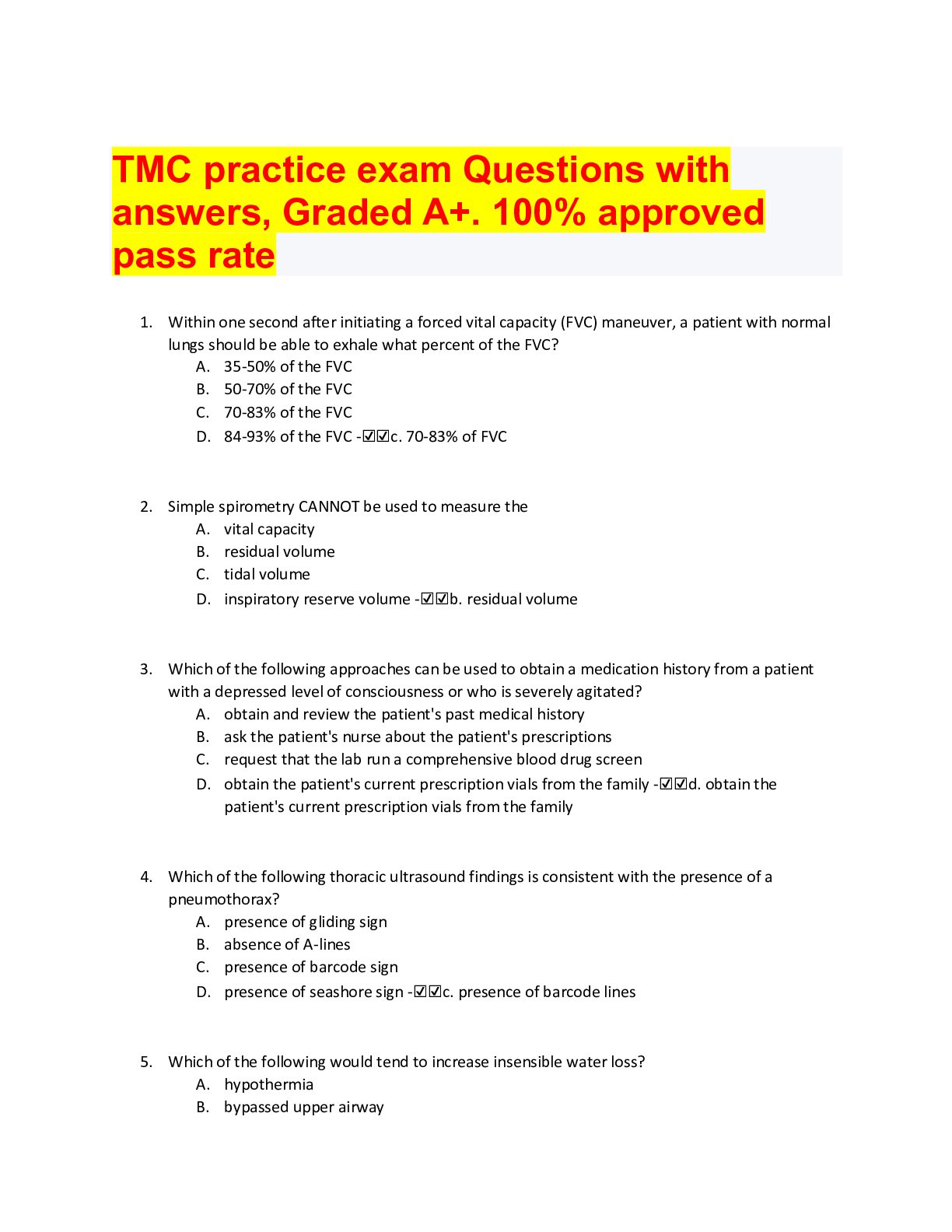
Also available in bundle (2)
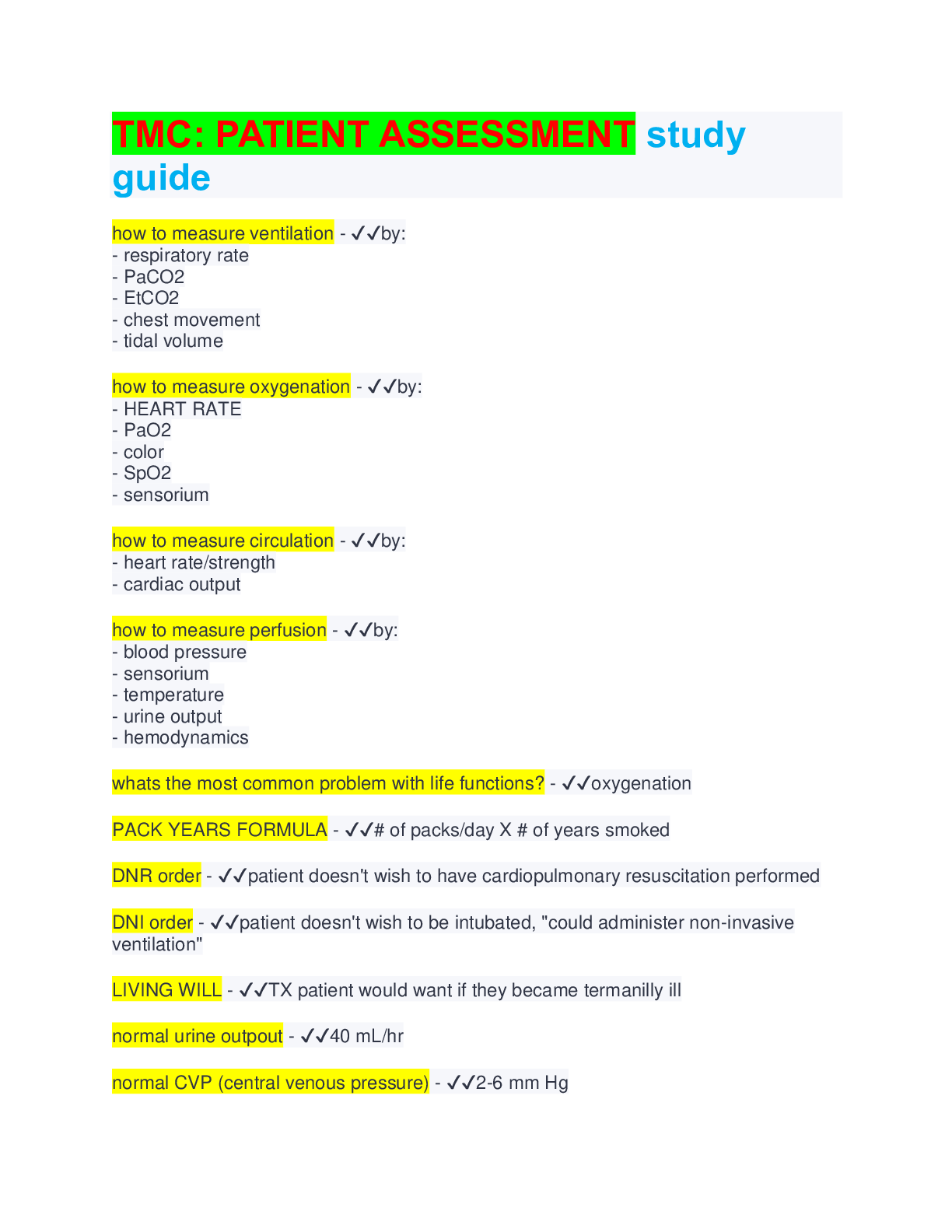
All TMC practice questions papers with answers. Bank questions. Download to score A
Most sought TMC revision kits. Guaranteed comprehension/ GRADE A+
By bundleHub Solution guider 1 year ago
$35
8
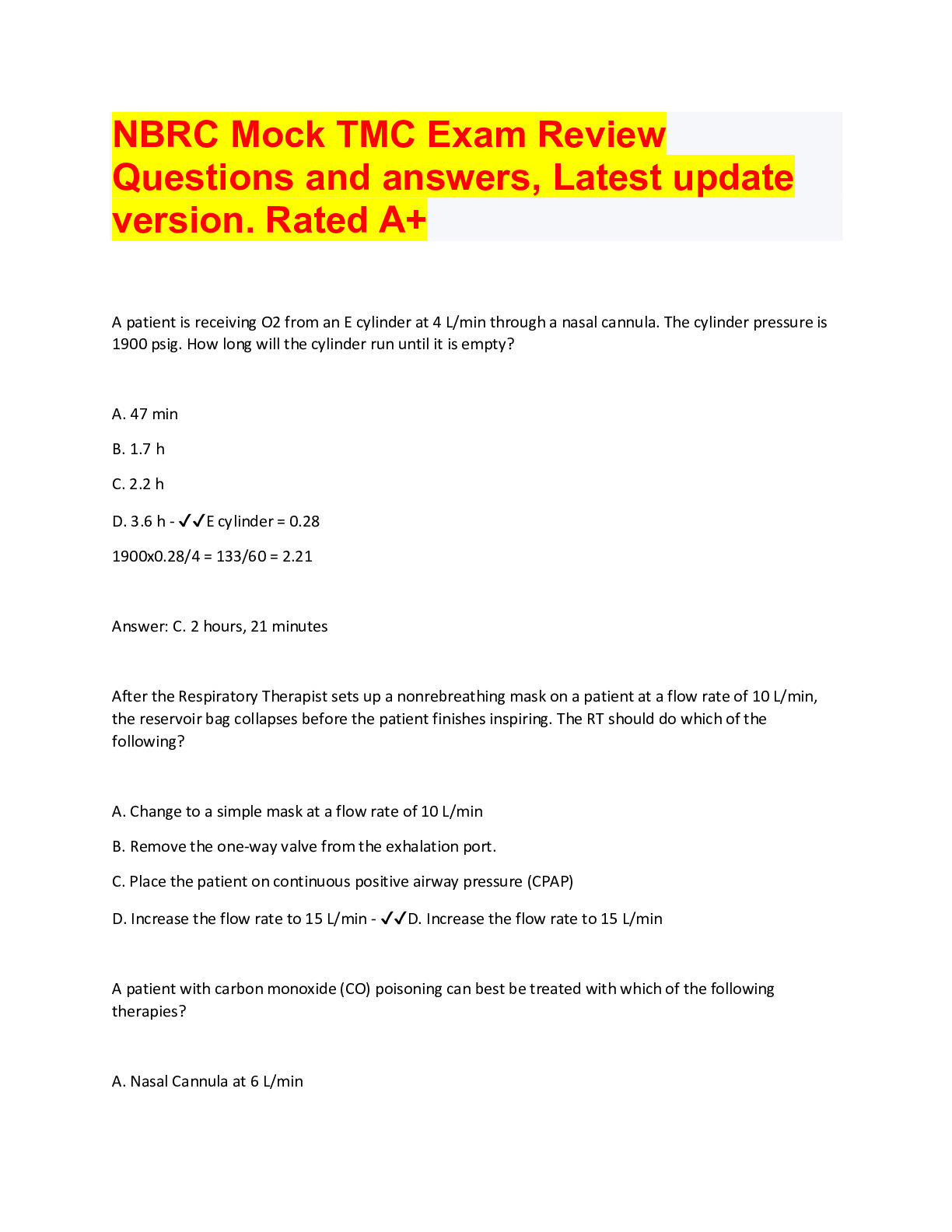
TMC EXAM BUNDLE, QUESTIONS WITH ACCURATE ANSWERS
ALL VERSIONS OF TMC EXAM PAPERS, BUNDLED QUESTIONS WITH ANSWERS, LATEST UPDATES
By bundleHub Solution guider 1 year ago
$38
16
Reviews( 0 )
Document information
Connected school, study & course
About the document
Uploaded On
Aug 07, 2022
Number of pages
20
Written in
Additional information
This document has been written for:
Uploaded
Aug 07, 2022
Downloads
0
Views
126

